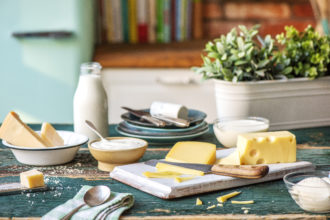List of Our 6 Favorite Root Vegetables January 23, 2017
Turnips and parsnips and beets, oh my! We’ve put together a list of root vegetables with all the recipes, tips, and tricks you need to make cooking these winter wonders as easy as eating them.
Listen up, team. We’ve been waiting all year for root vegetable season to come around. ALL YEAR. And now, it’s show time. Get your head in the game kitchen and don’t let the microwave win! Hands in everyone: one, two, three… GET COOKING!
1. Beets
Nutritional claim to fame: Beets have been used since ancient times for medicinal purposes, and it’s easy to see why. In addition to supporting blood circulation, they also come packed with folate, potassium, calcium, and iron.
How to choose: Select firm, plump, fresh-looking beets with crisp and vibrant greens.
How to store: Since beet greens leach moisture from the bulb, they should be immediately removed when you get home and placed in a separate bag. However, it’s important to leave about 1 inch of the stem attached to preserve the root’s color and nutrition.
When stored in a plastic bag in the refrigerator, uncooked beets will keep for up to three weeks whereas cooked beets will remain fresh for up to one week.
Did you know? Beets have the highest sugar content of any vegetable. Talk about a healthy way to satisfy that sweet tooth!
How to cook: Wash the roots (with the skin intact) before wrapping them individually in foil and placing on a baking sheet. Roast at 400ºF until easily pierced with a fork, 45 minutes to an hour. Once cool, peel away the skin.
Recipe: Beet and Goat Cheese Tart
2. Carrots
Nutritional claim to fame: These bright orange beauties are renowned for their high concentration of the antioxidant beta carotene in addition to Vitamin A. Together, the two help maintain healthy skin and eye health.
How to choose: If the greens are attached, be sure to opt for ones that are slightly moist and bright green. And when it comes to the carrots themselves, you want a firm and smooth exterior without any soft spots or white marks.
How to store: Keep in a plastic bag in the refrigerator drawer.
Did you know? Carrots were once considered an aprodisiac, which explains why the ancient Greek word for the vegetable, “philon,” is derived from the word “love.”
How to cook: For young carrots, feel free to skip the peeling. In fact, all they need is a quick rinse before slicing, roasting, or snacking. For older, larger carrots, peeling is the way to go.
Recipe: Shrimp Bahn Mi Burger with Sriracha Mayo and Carrot Fries
3. Turnips
Nutritional claim to fame: This white and purple-fleshed root is chock-full of immune boosting Vitamin C.
How to choose: Select ones with firm roots and bright-colored greens.
How to store: Keep tightly wrapped in the refrigerator for up to two weeks.
Did you know? Yellow turnips are called rutabagas.
How to cook: They can be enjoyed raw in salads, stir-fried, roasted, sauteed, or even steamed before mashing or pureeing.
Recipe: Creamy Pear and Turnip Soup with Radish, Pepitas and Toasted Baguette
4. Sweet Potatoes
Nutritional claim to fame: In addition to carrying a hefty dose of vitamins A and C, sweet potatoes also help stabilize blood sugar levels.
How to choose: Pick the small to medium-sized ones with smooth, unbruised skins.
How to store: Keep sweet potatoes far away from the sunlight. Instead, store in dry and dark environments where they’ll keep for three to four weeks.
Did you know? Sweet potatoes with darker skins are commonly referred to as yams. In reality, however, the true yam is not related to the sweet potato at all.
How to cook: After thoroughly scrubbing, pierce the skin with a fork and bake at 350ºF until soft, about one hour. And feel free to eat the skin, too!
Recipe: Chicken Paillard with Chimichurri, Sweet Potato Wedges, and Salad
5. Marble Potatoes
Nutritional claim to fame: They’re low in sodium, high in potassium, and a fabulous source of complex carbs to keep you energized all day long.
How to choose: Avoid potatoes that are wrinkled or sprouted. Instead, select firm, well-shaped ones.
How to store: Keep in a cool area away from the sunlight for up to two weeks.
Did you know? A “spud” is a sharp, narrow spade used to dig up rooted plants such as potatoes. However, sometime during the mid-19th century the term started being used to refer to the potato itself.
How to cook: Skip the peeling and the cutting! Thanks to their size, marble potatoes are incredibly simple to prepare and cook. All they need is a quick rinse before boiling, steaming, or roasting.
Recipe: Marble Potato and Brussels Sprout Hash with Fried Eggs, Red Cabbage, and Cayenne
6. Parsnips
Nutritional claim to fame: Parsnips boast an impressive amount of soluble fiber to help reduce cholesterol and boost heart health.
How to choose: Be on the lookout for small to medium roots that aren’t too thin and long. They shouldn’t show any signs of shriveling or significant spotting, and the tops should not be sprouted.
How to store: Wrap in paper towels, toss in a plastic bag, and refrigerate in the coldest part of your fridge for about two weeks.
Did you know? Once the first frost of the year passes and the parsnips’s starch is converted into sugar, they’re ready to be harvested.
How to cook: If cutting into chunks, peel before cooking. However, if you’re planning on mashing, peel after cooking to preserve color, flavor, and nutrients. Boil, steam, or roast — but watch carefully! If overcooked, parsnips loose their sweet side.
Recipe: Rosemary-Basted Steak with Roasted Parsnip Wedges and Garlicky Creamed Spinach
Before you head out to shop for root veggies, be sure to check out these 60 thoughts everyone has while grocery shopping for a good laugh.















